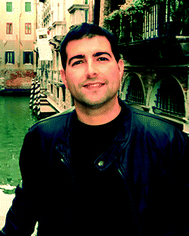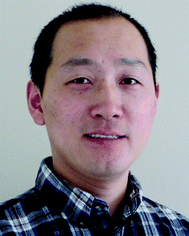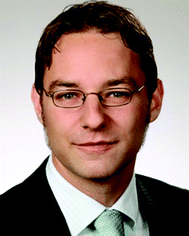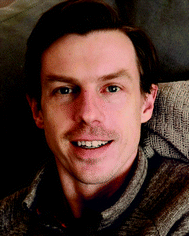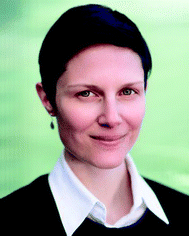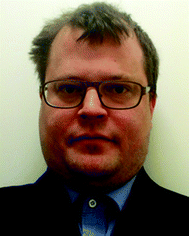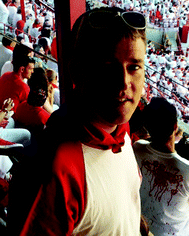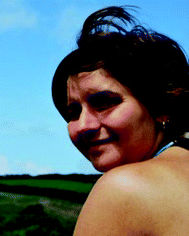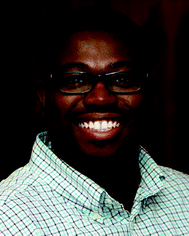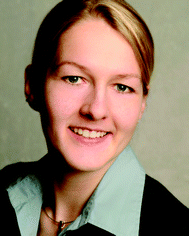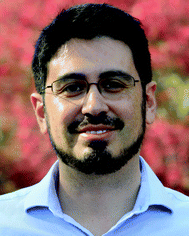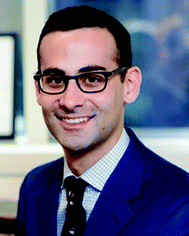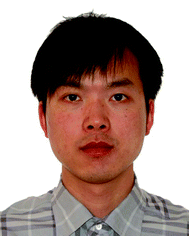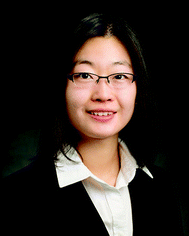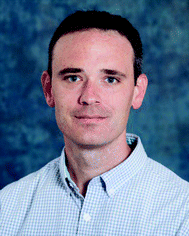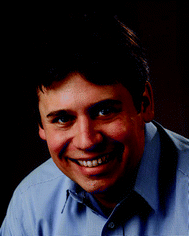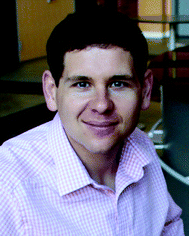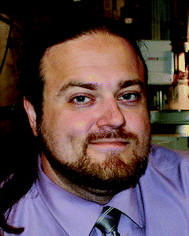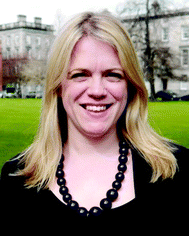DOI: 10.1039/C6TC90079H
(Profile)
J. Mater. Chem. C, 2016, 4, 3885-3889
Profile: Emerging Investigators 2016: novel design strategies for new functional materials
Agustín Mihi received a PhD in physics from the University of Seville, his research was carried out at the Institute of Materials Science of Seville (CSIC). Agustín has been awarded with a Beckman Institute postdoctoral fellowship at the University of Illinois at Urbana-Champaign, an ICFOnest research fellowship at the Institute of Photonic Sciences in Barcelona ICFO (Barcelona, Spain), the 2013-Martí Franqués Fellowship from the Rovira I Virgili University (Tarragona, Spain), a 2014 Ramón y Cajal Fellowship from the Spanish Ministry and a 2014 ERC Starting Grant. Agustín's research activities are mainly focused on the design, fabrication and characterization of photonic structures that enhance the light matter interaction in emerging optoelectronic devices. His profile is quite unique in terms of the expertise gained throughout the different institutions: a background in photonics (PhD), unusual nanofabrication techniques at the University of Illinois and experience in fabrication and characterization of optoelectronic devices at ICFO. In September 2015, Agustín joined the Institute of Materials Science of Barcelona (ICMAB-CSIC) as a Senior Researcher.
Feng Gao is an Assistant Professor at the Department of Physics, Chemistry and Biology (IFM) at Linköping University (Sweden), working on organic and perovskite optoelectronics. In his PhD work at the Cavendish Laboratory of the University of Cambridge (UK), he studied device physics of polymer-based solar cells. Before that, he obtained his BSc and MSc degrees in physics from Nanjing University (China).
Markus Gallei studied chemistry at the Technical University of Darmstadt in Germany, where he received his Diploma degree in 2007. For his PhD research he worked in the field of “Synthesis of Functional Metalloblock Copolymers” at the German Institute for Polymers (DKI) in Darmstadt. In 2011 he spent a year at the Helmholtz Centre Geesthacht (in the group of Prof. V. Abetz) working with stimuli-responsive polymer-based membranes before he went to the group of Professor Rehahn as junior researcher group leader. Besides the synthesis and applications of stimuli-responsive polymers and metallopolymers, his research interests focus on the preparation of polymer colloidal crystals and preceramic polymers.
Nicholas Strandwitz is an Assistant Professor in the Materials Science and Engineering Department at Lehigh University focusing on new techniques and chemistries in atomic layer deposition and interfacial electronic properties between semiconductors and dielectrics. His BS degree was obtained from The Pennsylvania State University in Engineering Science. He earned his PhD at U.C. Santa Barbara in the Materials Department under Prof. Galen D. Stucky and conducted postdoctoral studies at the California Institute of Technology with Prof. Nathan S. Lewis.
Nicole A. Benedek is an Assistant Professor in the Department of Materials Science and Engineering at Cornell University. After completing her PhD in Applied Physics and Chemistry at RMIT University, she left Australia (and any semblance of blue skies) for postdoctoral appointments at Imperial College London and Cornell University. Nicole then moved to the University of Texas at Austin, where she lead a double life as a member of a local improv theatre and as an Assistant Professor in the Materials Science and Engineering Program. Nicole returned to Cornell as faculty in July 2015.
Per Eklund (PhD 2007) is an Associate Professor and leads the Energy Materials Group of the Thin Film Physics Division at Linköping University, Sweden, where he joined the faculty in 2009. His main research interests encompass the wider area of thin-film ceramics primarily for energy applications, including thermoelectrics, ionic conductors, inherently nanolaminated ‘MAX phases’ and their 2D counterparts ‘MXenes’, and for electrical contacts and tools. Eklund has ∼100 published articles and an h index of 24. He is an ERC Starting Grant Holder, Wallenberg Academy Fellow and member of the Young Academy of Sweden (2011–2016).
Kyle N. Plunkett is an Associate Professor of Chemistry and Biochemistry at Southern Illinois University. He received a BS in chemistry from Texas A&M University (2000) and a PhD in chemistry from the University of Illinois at Urbana-Champaign under the guidance of Professor Jeffrey S. Moore (2005). He was an Alexander von Humboldt postdoctoral fellow at the Max Planck Institute for Polymer Research with Professor Klaus Müllen and a postdoctoral researcher at Columbia University with Professor Colin Nuckolls. His current research interests include the utilization of cyclopenta-fused polycyclic aromatic hydrocarbons as functional materials and the design and synthesis of morphology-controllable conducting polymers. His personal interests include home brewing hoppy American IPAs and German-originating beers, traveling (festivals are always a great destination), dreaming about owning a classic Chevrolet Camero or International Scout, wearing baseball caps, and Texas A&M football!
Sarah Staniland is not restricted by traditional scientific disciplines. She has a degree (MChem 2001) and PhD (magnetic materials, 2005) in Chemistry from the University of Edinburgh, undertook an EPSRC fellowship (2005–2008) based in Biology (Edinburgh) that involved working in biotechnology and geomicrobiology departments in Tokyo and Cape Town, and held a lectureship in Bionanoscience in the school of Physics and Astronomy at the University of Leeds (2008–2013). Sarah most recently completed the circle by moving back to a chemistry department, this time in the University of Sheffield, to take up a senior lectureship in Bionanoscience. She is a multidisciplinary scientist conducting research on the production of precise magnetic nanomaterials using biology: from extracting enhanced and modified magnetosomes from magnetic bacteria, to utilising the bacteria's biomineralisation proteins to control particle production in vitro, from biomimetic artificial magnetosomes, to the bioinspired surface fabrication that is the subject of this paper. When she was a new academic she was told “you are only as good as the people that work for you” and this is valuable advice. She is passionate about developing her highly skilled, diverse and international research group, which she is very proud of (two of which (Scott and Andrea) are co-authors of the paper). Sarah is a mother of two young children (2 and 5) and as a family enjoys walking their dog in the peak district combined with a lovely meal in a cosy pub.
Toby L. Nelson is an Assistant Professor in the Department of Chemistry at Oklahoma State University. He received his BS degree in Chemistry from Francis Marion University. He obtained his PhD in Organic Chemistry from the University of South Carolina in 2007. Then he moved to Carnegie Mellon University as a UNCF-Merck Postdoctoral Research Fellow under Prof. Richard D. McCullough. His research interests focus on the design and synthesis of organic semiconductors, supramolecular materials, sustainable chemistry and development of bioinspired materials for biological and energy applications.
Annette Andrieu-Brunsen studied Chemistry in Marburg (Germany) and completed her PhD from 2007 to 2010 at the Max Planck Institute for Polymer Research in Mainz (Germany) in the group of W. Knoll. Subsequently, she continued her research in Buenos Aires (Argentina), where she worked together with G. Soler Illia and O. Azzaroni on the pH-gating of ionic permselectivity in porous materials. This resulted in her strong interest in polymerization reactions at the nanoscopic scale and the control of pore accessibility. In October 2011, Dr Andrieu-Brunsen accepted the post of Associate Professor of Chemistry at TU Darmstadt, where she heads the “Smart Membranes” research group. In 2015 she was awarded the Exploration Grant of the Boehringer Ingelheim Stiftung and in 2016 the ADUC Preis for her research towards polymerization control in porous films.
Efrain E. Rodriguez, originally from West Texas, received his BS from the Massachusetts Institute of Technology and PhD in Materials at the University of California Santa Barbara. Afterwards, he received a National Research Council Post-doctoral Fellowship at the NIST Centre for Neutron Research. In 2012 he joined the Department of Chemistry and Biochemistry at the University of Maryland where he built a new solid-state chemistry laboratory for the preparation of inorganic materials. The group works at the dynamic intersection of materials chemistry and condensed matter physics with particular interest in iron-based superconductors, magnetic materials, transition metal oxides, crystallography, and neutron scattering.
Joe Gilroy is an Assistant Professor in the Department of Chemistry at Western University (aka The University of Western Ontario). Since his appointment in 2012, he and his group have been engaged in a diverse range of projects within the realm of synthetic materials chemistry towards the realization and application of molecular imaging agents, energy-purpose polymers, and metal-rich nanomaterials. He was the recipient of the Thieme Chemistry Journal Award and Western's Petro-Canada Young Innovator Award in 2014 and an Ontario Ministry of Research and Innovation Early Researcher Award in 2015.
James Rondinelli is an assistant professor at Northwestern University in the Materials Science and Engineering (MSE) Department. His interests are in electronic structure theory and first-principles design of functional complex inorganic materials. In 2016 he received a Sloan Research Fellowship in Physics and the Presidential Early Career Award for Scientists and Engineers (PECASE). Additional honours include an NSF-CAREER Award (2015), DARPA Young Faculty Award (2012), Ross Coffin Purdy Award from the American Ceramic Society (2012), and an ARO Young Investigator Program (YIP) award (2012). Dr Rondinelli has (co)-authored more than 80 peer-reviewed publications and holds 1 patent. He received a BS in MSE from Northwestern (2006) and a PhD in materials from the University of California, Santa Barbara (2010). From 2010–2011, he was the Joseph Katz Named Fellow in the X-ray Science Division at Argonne National Laboratory. Prior to joining Northwestern, he was an assistant professor at Drexel University (2011–2014).
Dang Yuan Lei received his BSc and MPhil degrees, both in Physics, from Northwest University and the Chinese University of Hong Kong in 2005 and 2007, respectively. He obtained his PhD degree in Physics from Imperial College London in 2011 and his PhD thesis was awarded Imperial's prestigious prize the “Anne Thorne PhD Thesis Prize”. Since September 2012, he has been an assistant professor with the Department of Applied Physics at the Hong Kong Polytechnic University. His current research centres on nanophotonics and nanomaterials studies (including two-dimensional nanomaterials), with particular interest in surface plasmon enhanced light–matter interaction at the nanoscale, and their applications in energy harvesting, optoelectronic devices, biochemical sensing and biomedical imaging. Since 2007, his research has produced 65 scientific publications, with a total number of 1470 citations and an H-index of 22 (by Google Scholar as of March 2016).
Dr Diao is the Dow Chemical Company Faculty Scholar and Assistant Professor at the University of Illinois at Urbana-Champaign. She received her PhD degree in Chemical Engineering from MIT in 2011. In her subsequent postdoctoral training at Stanford University, she pursued research in the thriving field of printed electronics. Her work has been frequently featured in science journals and news media. Within the past 4 years, Dr Diao has published over 30 peer-reviewed publications with total citations of >1000.
Chad Risko is an Assistant Professor of Chemistry at the University of Kentucky. A theoretical materials chemist by training, he received his PhD from the Georgia Institute of Technology and completed postdoctoral research at Northwestern University. With an eye towards developing novel materials design paradigms, Chad's research uncovers relationships among chemical structure, molecular packing, interfacial chemical processes, and the resulting electronic, redox, and optical properties of materials of interest for energy conversion and storage applications and new generations of electronic and optoelectronic devices.
James F. Cahoon received his BS in Chemistry and Philosophy from The College of William and Mary in 2003 and his PhD in Physical Chemistry from UC-Berkeley in 2008, where he worked in the field of ultrafast vibrational spectroscopy with Charles Harris. Beginning in 2009, he worked as an I.C. postdoctoral fellow with Charles Lieber at Harvard University, and he began his independent career at UNC-Chapel Hill in 2011. His group combines synthetic control of semiconductor nanomaterials with detailed physical characterization and modelling to rationally design new functional materials. He has won awards including the NSF CAREER, Packard Fellowship for Science and Engineering, Alfred P. Sloan Research Fellowship and Cottrell Scholar Award.
Jonathan Rivnay earned his BSc from Cornell University and his MSc and PhD from Stanford University (Materials Science and Engineering) where he studied the effect of defects and static disorder on charge transport in molecular and polymeric electronic materials. He then moved to the Department of Bioelectronics in the Centre Microelectronique de Provence (Gardanne, France) as a Marie Curie fellow where he investigated mixed ionic-electronic conduction and developed conducting polymer-based electrochemical transistor arrays and drug delivery devices for in vitro diagnostics and in vivo neural recording/stimulation. Since then (2015), Jonathan joined the Palo Alto Research Center (PARC; Palo Alto, CA), as a member of the research staff. His current research focuses on designing materials that can efficiently interface with the human body, and on understanding how devices based on those materials can record small biological signals.
Dr Alon Gorodetsky is an Assistant Professor in the Department of Chemical Engineering and Materials Science at the University of California, Irvine, with a joint appointment in the Department of Chemistry. Dr Gorodetsky obtained dual BS degrees in Engineering Physics and Materials Science at Cornell University and a PhD in Chemistry at the California Institute of Technology. He subsequently completed postdoctoral work as a National Science Foundation American Competitiveness in Chemistry Fellow at Columbia University. His current research is focused on the development of biologically inspired materials for camouflage and bioelectronics applications. Dr Gorodetsky has received several awards for his research, including the Samueli Faculty Career Development Fellowship, the Air Force Young Investigator Award, and the Presidential Early Career Award for Scientists and Engineers.
Jason Benedict started his career with a Bachelor of Science degree from Arizona State University in 2001 working in the field of fundamental reactions in inorganic chemistry. He then earned a PhD in 2007 from the University of Washington working under Professor Bart Kahr investigating the optical properties of oriented chromophores within technologically important materials. In 2008, Jason began his post-doctoral studies at the University at Buffalo under the guidance of Professor Philip Coppens that involved time-resolved X-ray diffraction and the synthesis of novel polyoxotitanate clusters for solar energy applications. Jason began his independent career at the University at Buffalo in 2011 where his research seeks to develop advanced in situ X-ray diffraction techniques to achieve a molecular level understanding of the physical processes that occur in stimuli-responsive nanoporous materials with the ultimate goal of being able to create ‘by design’ crystalline materials with tailor-made properties.
Rachel Evans is an Assistant Professor (since 2011) in the School of Chemistry at Trinity College Dublin, Ireland. A native of Wales, she obtained her MChem (2002) and PhD (2007) degrees from Swansea University under the supervision of Dr Peter Douglas and was awarded the RSC Ronald Belcher Award for her PhD studies. She subsequently moved to Portugal as an FCT postdoctoral fellow between the Universities of Coimbra and Aveiro. Rachel is the co-editor of the book Applied Photochemistry and her current research focuses on the use of interfacial engineering to design photoactive hybrid materials for application in optical sensors, solar energy conversion and light-emitting displays. She was named Young Leader of the Year at the 2014 Irish Lab Awards and elected as a Fellow of Trinity College in 2015. In her free time, you can find Rachel chasing the perfect wave.
| This journal is © The Royal Society of Chemistry 2016 |

